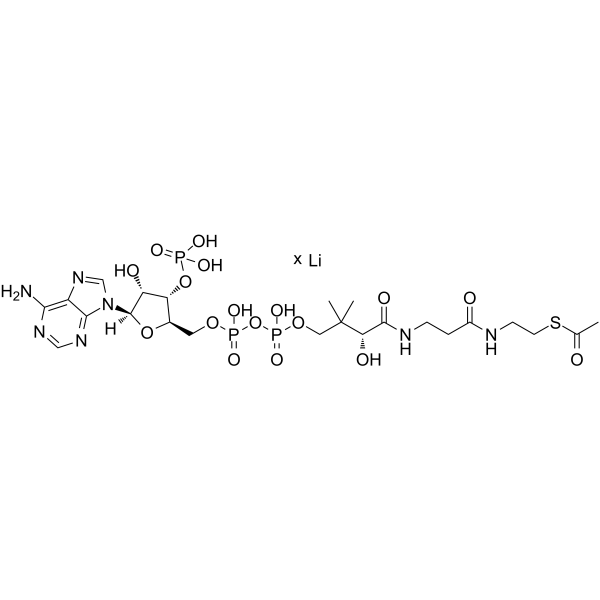32140-51-5
| Name | trilithium,[(2R,3S,4R,5R)-2-[[[[(3R)-4-[[3-(2-acetylsulfanylethylamino)-3-oxopropyl]amino]-3-hydroxy-2,2-dimethyl-4-oxobutoxy]-oxidophosphoryl]oxy-oxidophosphoryl]oxymethyl]-5-(6-aminopurin-9-yl)-4-hydroxyoxolan-3-yl] hydrogen phosphate |
|---|---|
| Synonyms |
Acetyl-S-CoA Li3
acetyl-CoA Acetyl coenzyme A lithium salt Lithiumacetyl-CoA |
| Description | Acetyl-coenzyme A (Acetyl-CoA) lithium is a membrane-impermeant central metabolic intermediate, participates in the TCA cycle and oxidative phosphorylation metabolism. Acetyl-coenzyme A lithium, regulates various cellular mechanisms by providing (sole donor) acetyl groups to target amino acid residues for post-translational acetylation reactions of proteins. Acetyl Coenzyme A lithium is also a key precursor of lipid synthesis[1][2][3][4]. |
|---|---|
| Related Catalog | |
| Target |
Human Endogenous Metabolite |
| In Vitro | Acetyl coenzyme A lithium increases cytoplasmic protein acetylation in starved U2OS cells while reducing starvation-induced autophagic fluxes. (U2OS cells stably expressing GFP-LC3 and are microinjected with Acetyl coenzyme A lithium; incubated in nutrient-free conditions in the presence of 100 nM BafA1 and fixed after 3 h)[2]. |
| In Vivo | Acetyl coenzyme A lithium blunts pressure overload-induced cardiomyopathy in a mice cardiac pressure overload model by Suppressing maladaptive autophagy[2][3].Mice deprived of food (but with access to water ad libitum) for 24 h exhibit a significant reduction in total Acetyl coenzyme A lithium levels in several organs, including the heart and muscles, corresponding to a decrease in protein acetylation levels. However, the same experimental conditions have no major effects on Acetyl coenzyme A lithium concentrations in the brain and actually increase hepatic Acetyl coenzyme A lithium and protein acetylation levels[4]. |
| References |
| Molecular Formula | C23H35Li3N7O17P3S |
|---|---|
| Molecular Weight | 827.37000 |
| Exact Mass | 827.15000 |
| PSA | 426.85000 |
| LogP | 1.36220 |
| Storage condition | 2-8°C |
| Symbol |

GHS07 |
|---|---|
| Signal Word | Warning |
| Hazard Statements | H315-H319-H335 |
| Precautionary Statements | P261-P305 + P351 + P338 |
| Personal Protective Equipment | dust mask type N95 (US);Eyeshields;Gloves |
| RIDADR | NONH for all modes of transport |
